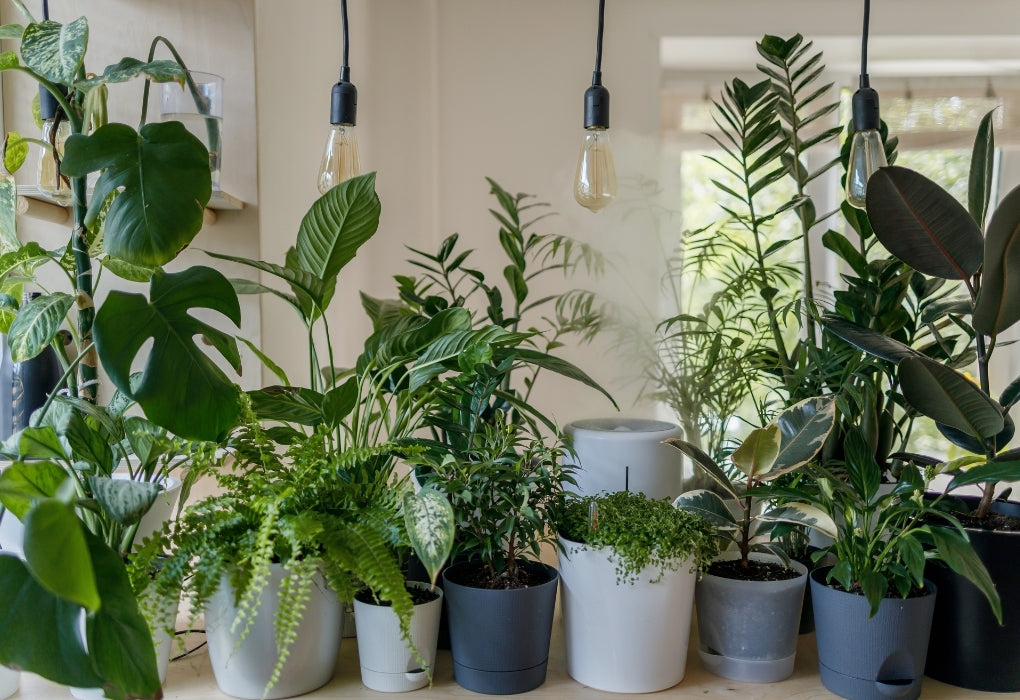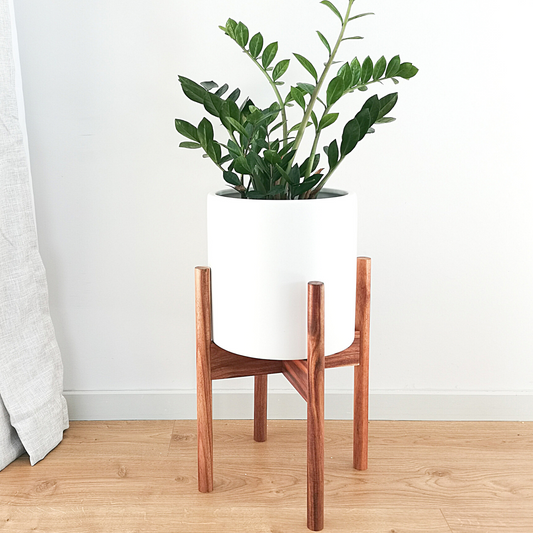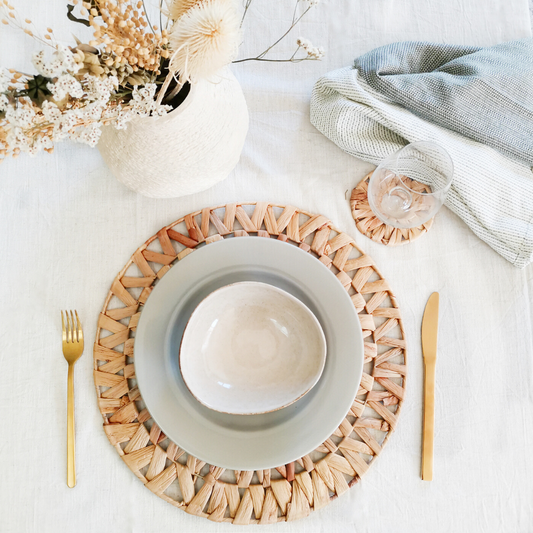
Whether you are a beginner who has just entered the world of indoor plant growing or have decided to get back into it after a while, knowing how to best grow your plants is the key to success. There are lots of things you must learn if you want to grow healthy plants at home, and this is where we want to help you with! This will be our first blog in our Blog Series - Indoor Planting Guide, where we will deep dive into the basics of Houseplant Care. Ready to turn your black thumb green?
We all know plants need light to survive. Plants use light to manufacture their own food through photosynthesis. However, not all plants need the same type or even amount of light. There are three lighting factors that affect the growth of your plants:
- The intensity of light: levels of light from full sun to full shade
- The amount of light: number of hours of light on your plants
- The spectrum: warm and cool colors
INTENSITY OF LIGHT
If you've been to a few plant shops, you'll sometimes see or hear the terms like "full sun", "indirect light", "low light", etc. Here's what they mean:
Full Sun / Bright Direct Light
Full sun or bright direct light is a pretty straightforward concept. This means direct, unobstructed sunlight⏤ no barriers like curtains, tree branches, or buildings that create shade between the plant and the light source (sunny window). This is where your plant will receive the most bright or direct light while indoors. A plant in a sunny southern or western-facing window would receive bright direct light. Generally speaking, plants that need "bright light" should get direct sun for at least 6 hours a day. Be careful though, plants also get sunburn.
Winter Tip: During winter, avoid moving your bright-light-loving plants closer to the window as they won't be able to handle the cold draft.

Bright Indirect Light
This is the type of light that most houseplants love! Bright indirect light means that the plant is in a bit of a shady area in a sunny spot where the sun's rays are not directly hitting it. Indirect light can usually be found in places with an east-facing window, or in a room that receives full light from a south- or west-facing window.
This light is created when there's anything partially obstructing the path between your light source (sunny window) and your plant. If there's a sheer curtain between your light source and your plant, this is also considered indirect light. Indirect light-loving plants will be happiest in a shaded window or a spot near a window that receives direct sunlight from the window.
Some also refer to this as "medium-light", "partial sunlight", "filtered sunlight", "dappled sunlight," but there are also some that consider "medium-light" to be less intense than bright indirect light. The key here is to do your research about the light requirements of your plant, and observe any sunburn warning signs like leaves curling, browning, wilting, etc.

Low Light (can be partial or full shade)
If you have space that has fairly low light, don't lose hope as there are plants that survive in low-light spaces! Low light means no direct sunlight will reach your plant. It could be a few feet away from your light source (sunny window), or the sunlight is being blocked by a nearby building (partially shaded windows). Rooms with north-facing would also qualify as low-light places.
Take note though that low-light loving plants still need light, meaning they won’t thrive if you'll shove them in a dark corner or a room with no windows at all.

If you want an accurate reading on the amount of light your plant is receiving, the best thing to do is use a light meter. It is a tool that measures the intensity of the light that is currently shining with a unit of measurement called foot-candles.
Or if you're not into using tools yet, one handy trick we know is the "Shadow Technique". This allows you to gauge the type of sunlight based on the appearance of the shadow cast by the plant.
Here's a quick table to help you see the light needs of some of the most common houseplants (take note that there are plants that can thrive well even in low-light conditions but they'll still benefit the most from well-lit spots) :

Some people also like to follow different window orientations (such as north-facing windows, south-facing windows, east-facing windows, and west-facing windows) to determine the best spot for their plants according to the plant's light intensity needs. We put together several quick tips for that in our FREE 7-Day Indoor Planting Mini-Course. Subscribe here if you want to receive them!
AMOUNT OF LIGHT
We understand some indoor plants can be tricky, and it can be difficult not knowing whether a plant is doing as well as it should be or if they're getting enough light or not but plants can communicate to us what they need⏤yes, they're amazing like that! If a plant is receiving too much light or not enough light, it will show certain symptoms of it.

Signs that your plants are getting TOO MUCH LIGHT:
- Leaves becoming burnt - looks like brown spots and scorched leaves
- Leaves are looking faded or washed out
- Leaves are dry and falling off
- Flowers tend to shrivel up and die
Signs that your plants are getting INSUFFICIENT LIGHT:
- No growth at all or slower rate than normal
- Looking weak and droopy
- Not producing as many leaves and flowers as it should
- New leaves are smaller than usual
- Yellowing leaves that tend to fall off
- New shoots tend to grow or reach out towards the light
SPECTRUM OF LIGHT

GROWING INDOOR PLANTS WITH ARTIFICIAL LIGHT
If you live in a particularly gloomy part of the world, or if your house doesn’t receive that much natural light, you can always supplement with artificial plant lighting or "grow lights". Some plant parents also use this as a remedy for their indoor garden during the winter months, when natural sunlight is at its lowest.
Artificial lights provide the sun's spectrum of wavelengths, which we identify as colors. A variety of them are available and you can choose depending on the type of plant or situation they're growing in.
- Cool blue and violet hues for foliage
Blue light can be very helpful for new plants that are in their early growth period because it increases the amount of chlorophyll that is formed - they help some seeds to sprout.
Violet light can be used at any point in the plant’s life to enhance the color of a plant or even the taste of the plant's fruits - they help protect plants from damage and increases the antioxidant the plants produces.
- Warm red and orange for flowering
Red lights are great for mature plants that are beginning to flower.
Although it may be tempting to choose a light that is concentrated on color, plants need to have a bit of each color to grow healthy. A great starting choice would be fluorescent lights. They are not very expensive and are efficient because they provide the blue and red parts of the spectrum.
Lastly, although this depends on the type of plants, it is best to turn on grow lights for 8-12 hours per day, mirroring the time of natural daylight. Try to have the lights on at the same time every day. But, you still have to do some research around here as foliage plants and flowering plants have varying needs.
And that's it for our first blog in our Indoor Planting Guide. We hope we were able to equip you with the right knowledge and tools you need to understand the lighting requirements of your houseplants.
Indoor planting is a continuous process and you might need to do some testing to find the perfect growing conditions for each of your plant friends. Happy planting!
This post may contain affiliate links. At Alfie & Gem, we’re here to help you make your house a home - whether it's finding decor choices for your space or care tips for your plants. All of our picks are independently selected and curated by our team. If you buy something we link to on our site, your cost for the products will be no higher but we may receive a small commission. Thank you - we're honored to be part of your home decorating and plant growing journey!








